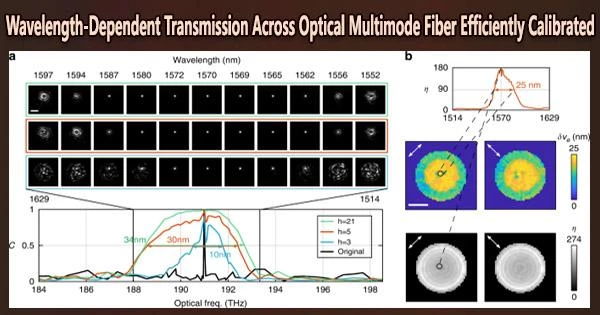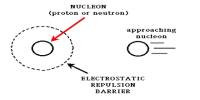Optical multimode fiber (MMF) is a type of optical fiber that is used to transmit light over long distances in telecommunications and data communication systems. Unlike single-mode fibers that only allow one mode of light to propagate, multimode fibers support multiple modes of light transmission, hence the name.
Researchers at the Wellman Center for Photomedicine have demonstrated that wavelength-dependent changes in the spatial distribution of light transmitted through a multimode optical fiber are not random but highly predictable.
For effective measurement of the transmission of light through the fiber across a spectrum of wavelengths, they created a dispersion model and computational algorithms. Applications in bioimaging and telecommunication hold tremendous possibilities for controlling the spatial transmission of light with various wavelengths through multimode fiber.
Multimode fiber (MMF) consists of a light-guiding core embedded in a cladding with a diameter of typically only 125 µm, about the thickness of a human hair. MMF includes hundreds to thousands of spatial modes that travel at different speeds and regularly pair with one another. This is in contrast to single mode fiber, which has a core that is only large enough to guide a single spatial mode.
As a result, MMF transmits light effectively but loses its spatial pattern. An output that appears random is produced when an input signal links to a variety of modes that mix and experience different phase delays.
The ability to efficiently calibrate the fiber’s multispectral transmission matrix may be decisive for my team’s efforts of imaging through flexible MMF. This future goal will require overcoming another prevailing challenge of controlling light transmission through MMF: The challenge of fiber deformation and the way it changes the transmission matrix.
Martin Villiger
However, there is a linear relationship between the input and output electromagnetic fields, and the coherent transmission matrix of the fiber is defined by the coupling coefficients between all associated input and output modes. In this view, MMF can be treated as an uncommon optical element.
The influence of the transmission matrix can be countered computationally or with the use of a spatial light modulator once it is known, often by calibration. Future applications of progress in regulating light transmission through such complex media include spatial multiplexing in telecommunications and imaging through MMF for use as a small endoscope in biology.
One of the prevailing challenges with controlling light transmission through MMF is the wavelength-dependence of the fiber’s transmission matrix. In general, a seemingly independent distribution of the transmitted field results from a slight shift in wavelength. The laborious calibration of transmission matrices at each wavelength has been necessary for controlled transmission at many wavelengths.
In a new paper published in Light: Science & Applications, researchers at the Wellman Center for Photomedicine in Boston now demonstrate that, far from random, the wavelength-dependence of the multimode fiber transmission matrix is highly deterministic. Instead of requiring dense spectral data, they created a parametric dispersion model and computational techniques for effective calibration of a fiber’s multispectral transmission matrix.
The possibility of finding a particular set of input patterns and related output patterns that are largely insensitive to a change in wavelength has long been acknowledged. The fiber transmits a pulse of light thrown into one of these “principal modes” without temporal scattering and with a mode-characteristic delay.
“In order to achieve full spatial and spectral control, we need to be able to generate a suitable superposition of all principal modes by accounting for the phase offsets between the various modes and how these phases change with wavelength,” explains Szu-Yu Lee, lead author of the study and recent Ph.D. graduate from the Health Sciences and Technology program between MIT and Harvard.
In addition, while the principal modes offer the smallest possible wavelength-dependence, they eventually do change in response to a sufficient wavelength variation.
Szu-Yu’s co-authors are Vicente Parot, formerly a postdoctoral researcher at the Wellman Center for Photomedicine and now Assistant Professor at the Pontificia Universidad Católica de Chile, Brett E. Bouma, Professor at the Wellman Center for Photomedicine, and Martin Villiger, Assistant Professor at the Wellman Center for Photomedicine.
The group realized that the algebraic idea of an exponential map might effectively express the required management of the wavelength-dependent modal phase delays. It was also possible to account for more widespread wavelength dependency by breaking down the dispersion into several orders of wavelength dependence.
The modeling of dispersion in lower dimensional systems, such as free-space propagation through glass or polarization mode dispersion in single mode fibers, served as the basis for this formulation.
Combined with suitable computational tools, Szu-Yu and his colleagues demonstrate in the study how the model can be fitted to experimental transmission matrices measured at only a few discrete wavelengths. Crucially, the parameterization enables inter and extrapolation over a continuous range of wavelengths.
“The ability to efficiently calibrate the fiber’s multispectral transmission matrix may be decisive for my team’s efforts of imaging through flexible MMF. This future goal will require overcoming another prevailing challenge of controlling light transmission through MMF: The challenge of fiber deformation and the way it changes the transmission matrix,” explains senior author Martin Villiger.
















